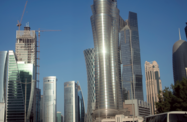Qatar’s economy maintained steady growth throughout 2017, with forecasts of a stronger year to come as efforts to boost self-sufficiency in key sectors gain traction.

The biggest issue facing the state in 2017 was the diplomatic and economic blockade of the country announced by Saudi Arabia and other regional powers, including the UAE, Bahrain and Egypt, in June.
Land access was closed and much of Qatar’s air traffic rerouted as a result, hampering the delivery of imports. And while the authorities have implemented a series of measures to mitigate the impact of the stand-off – including increasing trade activity with Turkey and Iran to provide goods and services no longer available regionally – the issue will continue to shape trade and investment flows heading into 2018.
Blockade spurs diversification strategy
Though the dispute has impacted the economy, some believe the issue could generate a series of long-term positives, with the government enhancing efforts to diversify and increase self-reliance.
“Given the regional tensions that arose in mid-2017, there were some hurdles to overcome,” Abdulla Bukhowa, CEO of Standard Chartered Qatar, told OBG. “The year 2017 has been something of an adjustment, as the country faces this new reality. Preparation and planning taking place now will generate a strong rebound across the entire economy in 2018.”
Some of the measures implemented to boost self-sufficiency include investments in the production of domestic dairy, meat and poultry products, as well as food processing and light industry.
One example was seen through the decision to purchase 14,000 cows and construct a dairy farm to address the country’s reliance on imports. According to industry officials, the move should allow Qatar to be milk self-sufficient by mid-2018.
Economic growth to remain above regional average
Despite the external headwinds, Qatar remained a regional leader in terms of economic expansion this year.
The economy is forecast to expand by 2.5% in 2017 and 3.1% in 2018, according to the latest IMF estimates, released at the end of October. This is higher than growth estimates for the Middle East as a whole, which the IMF predicts will expand by 1.3% this year and 2.8% in 2018.
In an earlier report, issued at the end of August, the fund said Qatar’s current account position was set to improve to a surplus of around 3.9% of GDP in 2017, rebounding from a deficit of 7.7% in 2016, largely due to a contraction in imports and the recovery in oil prices.
Banking stays resilient despite outflows
Qatar’s banking sector has also been impacted by the diplomatic crisis as foreigners with funds in the country moved to withdraw their capital.
Prompt action by the government forestalled any instability in the financial services sector, with the transfer of funds – much of which came from the Qatar Investment Authority – easing concerns of a liquidity crisis. The requirement for such transfers has eased as local lenders move to secure funds from banks in Asia and Europe, rather than regional sources.
Confidence in the banking sector has seen deposit levels at commercial banks rise after a mid-year dip; total deposits stood at QR794.3bn ($218.2bn) at the end of October, up from the QR736bn ($202.2bn) recorded in January.
Lifting of gas moratorium to boost energy output
The year 2017 also saw Qatar increase its energy output. In April the government announced it was lifting a 2005 moratorium on further development of its main gas reserve, the North Field, part of a programme aimed at lifting annual gas output to 100m tonnes by 2024, up from the 78.7m tonnes posted last year.
Bringing the southern section of the North Field into production would add 2bn cu feet per day to gas capacity, according to the authorities, representing 10% of the field’s current output.
The increased capacity will lift Qatar’s earning potential and allow it to address growing global demand in the coming years. It is also expected to strengthen the country’s position as the world’s leading liquefied natural gas exporter amid increasing competition from countries such as Australia and Russia.
Inflation set to edge up in 2018
While identifying new sources of imported goods and boosting investment in self-sufficiency projects will help Qatar meet its commodity needs, the higher cost of bringing in goods from further afield and increased outlays at home could fuel inflation next year.
This expected rise could be further pushed up by the planned introduction of a value-added tax, which is expected to add 5% to the cost of most goods and services in a range of sectors, including retail, real estate, industry and financial services.
This does not appear to represent a challenge to the Qatari economy, however, as inflation eased from 2% year-on-year at the beginning of 2017 to negative 0.2% in the third quarter, according to the latest central bank data.


